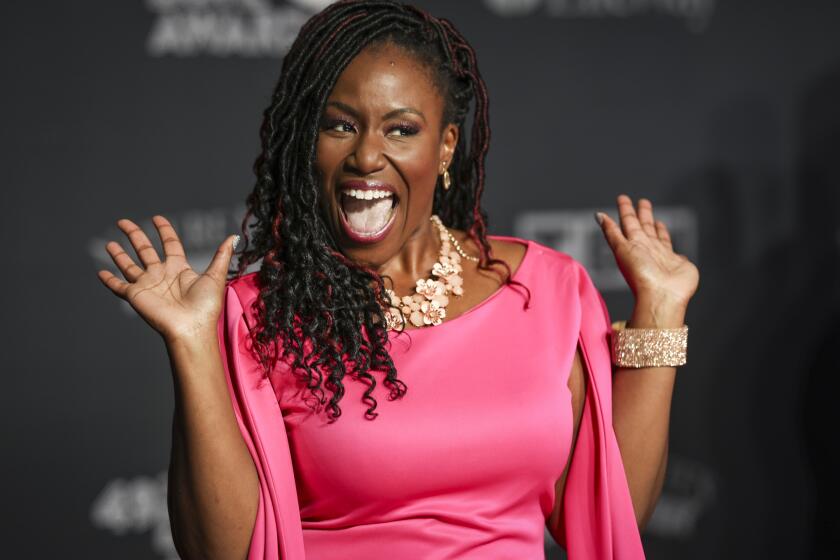What compelling characters
Attention, screenwriters and casting directors: If you are currently pacing around an airless office searching for a marvelous supporting character and/or actress to add zest and texture to your modern comedy or drama, I give you Margot Kidder as the crusty lesbian guidance counselor in “On the Other Hand, Death,” which premieres tonight on the subscription television network
Kidder, who famously disappeared from the screen after a mental breakdown in the 1990s, has resurfaced recently in roles on “Brothers & Sisters,” “Smallville” and “The L Word.” She is 60 and, God bless her soul, she looks it, in that great hard-living, nonlifted way that is becoming so rare on television these days. As Dorothy, a recently out and besieged activist guidance counselor, Kidder uses that fine-grain sandpaper voice and thrusting jaw of hers to conjure every fabulous soft-hearted, angry lesbian English teacher or lacrosse coach you ever had. Margot Kidder, people. Think about it.
If Kidder is the most surprising thing about “On the Other Hand, Death,” she is not the only good thing. Based on the book by Richard Stevenson, the work is part of a series following Donald Strachey, a tough-as-nails private eye. And, oh, yeah, he’s gay.
For those not familiar with here!, it has, over the last six years, created a unique niche -- genre television in which the primary characters are gay and lesbian.
There’s “Dante’s Cove,” a steamy supernatural soap; “The Lair,” a steamy vampire soap; “Paradise Cove,” a steamy soap soap; as well as a series of gay-themed films, including most recently “Kiss Me Deadly,” a spy thriller; and now, “On the Other Hand, Death.”
Though it opens with an attempt at noir, “On the Other Hand, Death” winds up more noir-adjacent. Not that this is a bad thing. Stevenson and the filmmakers are primarily concerned with answering the question that has plagued many of us over the years: Why do gay character roles so often have to be about their sexuality? Why can’t the doctor, lawyer or private eye just happen to be comfortably gay?
They can, it turns out, if writers Gillian Horvath and Ron McGee and director Ron Oliver would just go a little easier on the tolerance preaching.
Strachey, played winningly by Chad Allen (who, for trivia buffs, began his career as little Tommy Westphall in “St. Elsewhere”), may eschew the traditional accouterment of a gumshoe -- he isn’t a drunk, he is happily married -- but still he makes trouble his business.
A plot unfolds that would not be out of place on any network detective show: In what appears to be a small New England town, a lesbian couple are being terrorized by what appears to be an anti-gay vandal. Indeed, Dorothy (Kidder), the local high school guidance counselor, has recently come out and is now being put on paid leave for advising one of her probably gay students to contact a hotline for “questioning youth.”
Strachey is drawn into their case through Andrew (Damon Runyon), who is the ex-boyfriend of his partner, Tim (Sebastian Spence), and quickly concludes it may be connected to another case he and his assistant (Nelson Wong) are working on involving a local business tycoon (Sean Allan).
There are a lot of good-looking gay men to keep track of, but there are worse problems a television show could have. Strachey is an old-fashioned PI, not afraid to pull a fire alarm so he can break into a building and steal a file or two (Paper ones! Just like in the old days!) or make info-swapping deals with the local cops.
All is not what it seems, and virtually everyone has a secret, some more satisfying than others. Stripped to its basics, “On the Other Hand, Death,” is not only a decent mystery, it’s a compelling love story, or stories.
Strachey and Tim have wonderful moments as men trying to come to terms with actually being happy with each other while Dorothy and her partner, Edith (played by a terrific Gabrielle Rose), capture the sacrifice and compromise even true love requires over the years.
It is unfortunate that the filmmakers didn’t trust these elements to deliver their message of love and tolerance, but they didn’t, and so there are long moments when the plot is dragged down with a preachy story line about those “questioning youths” and some tired stereotypes about bigotry (Why do homophobes always have to be idiotic Christians?). There are a few glaring plot inconsistencies -- how could a small town be homophobic when it seems fully half of its citizens are gay -- and one of the longest explanatory monologues in the history of the genre.
But there’s a lot of heart in “On the Other Hand, Death,” and the performances are all so consistently fine that you can’t help but think how much better things would be in the hands of the folks at FX or HBO, where there is not such a ham-fisted consciousness-raising mandate.
I have always wondered why we couldn’t have a “Nikki and Nora” or “McMillan and Husband” setup. “On the Other Hand, Death” goes far in proving that we could. Especially if there’s a good role for Margot Kidder.
--
--
‘On the Other Hand, Death’
Where: here! TV
When: On demand on some cable systems
Rating: TV-MA (may be unsuitable for children younger than 17)
The complete guide to home viewing
Get Screen Gab for everything about the TV shows and streaming movies everyone’s talking about.
You may occasionally receive promotional content from the Los Angeles Times.




